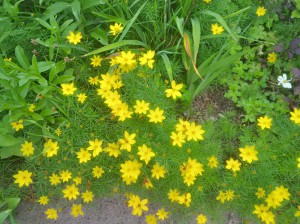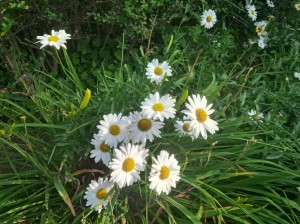
I am forever acquiring new plant species and varieties, mostly because I am an easy mark for plant merchandisers. A trip to a good garden center—and there are several of them within an easy drive of my house—brings me face to face with all kinds of temptation and I often give in. I am lucky that the size of my pocketbook limits my purchases. Otherwise my garden, porches and house would be subsumed by plants.
In seasons like this one, when every plant is growing high and wide, I occasionally feel as if I am already there.
As I confront the raging tide of summer perennials, I think about the stalwarts. These are the plants that do well in wet and dry years and stomp weeds in all seasons. They have survived the worst that winter can dish out, along with monsoon-like deluges, high winds, deer and a gardener who doesn’t divide them often enough. If I had to go back to basics and choose only three plant varieties for my summer garden, the following would be my choices.

Shasta Daisies: Named after California’s Mount Shasta, the Shasta daisy—Leucanthemum x superbum–was developed 114 years ago by great American plantsman, Luther Burbank. In hybridizing the Shasta, Burbank aimed to produce a tough, long-lasting perennial that would bear large-flowered daisies with pure white petals and a large, sunny yellow center. Combining the best traits of four different species, including the common ox-eye daisy—Leucanthemum vulgare—Burbank hit the mark, creating plants that stand tall and proud at up to four feet tall, with flowers up to three inches wide. In my yard the Shastas begin flowering in late June or early July, depending on weather, and continue for several weeks. Normally the sturdy stems do not require staking, though they do bend in the rain. Fastidious gardeners might corral them with stakes and string. Non-fastidious gardeners should do what I do and cut the bent or sagging stems to bring indoors for flower arrangements. The blooms last just this side of forever in a vase.
The deer that populate my neighborhood ignore Shasta daisies, much as they ignore other members of the closely-related Chrysanthemum clan. The daisy clumps increase in size from year to year and bear abundantly, even when not divided regularly. However, if you are a beginning gardener and need to populate your acreage quickly, I recommend dividing Shastas every couple of years. You will end up with daisies in all the right places, creating the repetition that garden designers always advocate.

‘Hyperion’ Daylilies: ‘Hyperion’, introduced in 1924, stands out amid the sea of daylily varieties because of its reliability, elegant form, extremely fragrant flowers and tall stature. The flowers are glowing yellow, without the fussy ruffles or furbelows that characterize some modern daylilies. Borne on stalks up to three feet tall, the blooms generally appear in early to mid July. Unlike the modern favorite ‘Stella de Oro’, ‘Hyperion’ does not rebloom. However, a mature clump will produce many buds, which continue opening and closing daily over a period of ten days or more. The plants will also flower in light shade, which sets them apart.
I suspect, along with other garden lovers, that ‘Hyperion’ was bred from an Asian daylily, Hemerocallis flava, sometimes known as Hemerocallis lilioasphodelus, aka “the lemon lily.’ Lemon lilies share ‘Hyperion’s yellow flowers and pervasive lemony fragrance. In keeping with its heroic qualities, the variety was named after one of the Titans of classical mythology. Hyperion, the Titan, was the father of Helios, the sun god; moon goddess, Selene, and Eos, goddess of the dawn. In mythology, as in the garden, all good things seem to spring from ‘Hyperion’.
The only downside to ‘Hyperion’, and it is slight, is the need to divide the plants every few years. The job is easy, as the daylily is shallow rooted, and can be lifted from the earth and divided with a trowel or small spade. This need is also a blessing in disguise, as dividing ‘Hyperion’ means that you will always have more of them.
Coreopsis ‘Zagreb’: The past couple of decades have given rise to a coreopsis explosion, but ‘Zagreb’, an old favorite, is still one of the best. These little golden daisies are part of the threadleaf or verticillata coreopsis species, which features small, slender leaves. The flowers are similarly diminutive, each less than one inch in diameter, but there are many of them on every clumping plant. In my garden, ‘Zagreb’ reaches about one foot in height, with a mounding habit that fills space nicely, surging around the feet of taller specimens. The plants are partial to sunshine, but are not fussy about soil quality or water amounts.
One of ‘Zagreb’s best qualities is its reblooming habit. The first flush happens in early July in my area. Shearing back the faded blossoms produces another flush later in the summer, especially if you water regularly. If your growing season is long enough, you may get a third flush in the fall. While all this blooming is going on, a happy ‘Zagreb’ will also bulk up, spreading by means of underground rhizomes. It is vigorous, but not aggressive. The much more aggressive Mr. Antlers and his family tend to avoid ‘Zagreb’ under normal circumstances in my garden.
Unless I had the misfortune to be barred for life from garden centers, I doubt that I could ever restrict myself to only three summer-flowering plants. However, it is comforting to know that no matter how wild and crazy I get with new and different plants, Shasta daisies, ‘Hyperion’ daylilies and ‘Zagreb’ coreopsis will continue to be the mainstays of my beds and borders.
